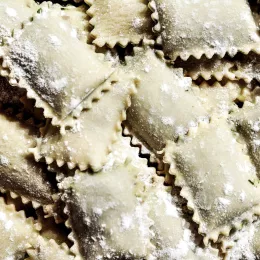On a Friday evening in November, when the weekend held the promise of a just-ordered ShackBurger, I nabbed a seat in ICE Director of Wine Studies Richard Vayda’s course: Great Holiday Wines for under $20 and over $50. Armed with an open palate, I tasted nearly a dozen wines, from sparkling rosé and viognier to rich red and sweet fortified; two of each, one a (relative) bargain, the other a splurge.
While we swirled, sniffed, sipped, and nibbled, I gleaned some grape wisdom — about wine varieties and my own tastes. In the spirit of holiday giving, here are five surprising takeaways from my wine course at ICE.
- Catalunya makes impressive under-$20 sparklers. The moment you utter “sparkling wine,” everyone’s mind zooms off to the famed region of France: Champagne, where due to a combination of tradition and soil, the best sparklers in the world are made, so they say (especially if “they,” like my wine course companion, happen to be French).
But at $18, a Catalunya-grown Brut Reserva Rosé made by Marqués de Gelida was a delicious steal. Really, I was tempted to steal the bottle (but I didn’t, of course). Medium-bodied, refreshing and with a faint aroma of ripe cherries, this wine is the perfect choice to kick off any holiday dinner.
- There’s a world of white wine outside sauv blanc and alby: Meet viogner. To be honest, when it comes to white wine, I tend to stick with my tried-and-true arsenal — sauvignon blanc from New Zealand and albariño from Spain. So when Richard said we’d be trying two viogniers, I was pumped to expand my list of white wine go-tos.
When I realized that my preferred viognier — La Linda Viognier from Mendoza, Argentina — was the bargain bottle ($13), I felt happy as a girl with new pajamas. Light and not too sweet, like a fresh, herbal tea with hints of lemon, it’s the kind of bottle to stock up on before any holiday party.
- Blind taste testing opens your mind + palate. The good thing about blind taste testing is that your usual proclivities go out the window. My own love affair with Spain, a place I called home for two years, means love at first sight whenever I see a label from the Iberian Peninsula. As we swirled and sniffed the three rich reds, I could identify a young wine, a middle-aged wine and an old wine, with a distinct red-orange color.
Unlike white wine, which gains color, red wine loses color as it ages. The older wine, which turned out to be from Rioja, the renowned Spanish wine region, did not make me as weak in the knees as I anticipated. I preferred the 2012 Châtaeu d’Arcins Cru Bourgeois from Bordeaux to the 2001 Castillo Ygay Gran Reserva Especial from Rioja. Either my palate isn’t refined enough to appreciate the nuance of this aged red or I just don’t love the stuff — either way, my preferred bottle ($14) was considerably more pocket-friendly than its Spanish counterpart ($80).
- Blonde ports have more fun. Or more aptly stated, I have more fun drinking these light-colored port wines. Port is a fortified wine produced in the Duoro Valley of northern Portugal. Before this class, the luscious, dark red-purplish port, Graham’s Six Grapes Porto ($20), said older and better to me. Think again. Like red wine, port wine loses color with age. The lighter colored 20-Year Old Tawny Port made by Taylor Fladgate ($50) had a rich, nutty flavor, probably due to its extra years in the barrel, and was much more to my liking.
I guess I’m more a peanut butter than a jelly girl when it comes to port. Fun fact: Tawny is generally enjoyed as a dessert drink — but as Richard would tell you, there are no hard-and-fast rules to wine drinking, so you can drink it throughout a meal if you like. Had the pours been larger or the bottles left with us, I could have sipped the Tawny all class long.
- I am not a “super smeller” – but I can still identify over 1000 smells. Super smellers, for better or worse, can identify over 6,000 smells. That’s an exhausting amount of olfactory stimulation. I pity the super smellers in the East Village on a steamy summer morning. But it certainly helps them to enjoy a glass of wine — after all, appreciating wine is more about smell than taste.
Though I can’t identify over 6,000 smells and am still trying to expand my vocabulary beyond flowery, bright … strawberries!!, this class proved to me that I know more about the nuance of wine than I previously thought. In fact, the average person can identify at least 1,000 smells. The more I taste, the more I articulate, and the more I can appreciate. Bottom line: taste more, talk more and always enjoy.
Ready to take your wine knowledge to new levels? Click here to register for a wine course at ICE.





